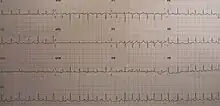| Electrical alternans | |
|---|---|
 | |
| Electrical alternans, tachycardia, and low voltage in a person with a large pericardial effusion. | |
| Specialty | Cardiology |
Electrical alternans is an electrocardiographic phenomenon of alternation of QRS complex amplitude or axis between beats and a possible wandering base-line. It is seen in cardiac tamponade and severe pericardial effusion and is thought to be related to changes in the ventricular electrical axis due to fluid in the pericardium, as the heart essentially wobbles in the fluid filled pericardial sac.[1]
The echocardiogram of the heart demonstrated the characteristic swinging along with alternating voltage on the ECG.[2]
Causes
The two most common causes of electrical alternans are cardiac tamponade and pericardial effusion. In this case, the heart's pendulum-like motion and rotation from beat to beat, which the ECG electrodes detect as varying amplitudes, is what causes the classic ECG rhythm. In addition, electrical alternans can be observed in conduction and refractory changes in a variety of rhythms, including the ones previously mentioned, which causes the electrodes to detect a range of QRS amplitudes.[3]
See also
References
- ↑ Antonio Bayés de Luna (2011). Clinical Arrhythmology. John Wiley and Sons. p. 351. ISBN 9781444391732.
- ↑ Jehangir, Waqas; Osman, Mohamed (2015-08-20). "Electrical Alternans with Pericardial Tamponade". New England Journal of Medicine. 373 (8): e10. doi:10.1056/NEJMicm1408805. ISSN 0028-4793. PMID 26287870.
- ↑ Ingram, David; Strecker-McGraw, Margaret K. (April 7, 2023). "Electrical Alternans". StatPearls Publishing. PMID 30480962. Retrieved December 29, 2023.
Further reading
- M, Goyal; KM, Woods; JE, Atwood (August 2013). "Electrical alternans: a sign, not a diagnosis". Southern Medical Journal. South Med J. 106 (8): 485–489. doi:10.1097/SMJ.0b013e3182a1456c. ISSN 1541-8243. PMID 23912146. S2CID 19681969. Retrieved December 29, 2023.
- Mittal, Sitaram (2023). "Electrical Alternans". Insights into Electrocardiograms with MCQs. Singapore: Springer Nature Singapore. pp. 681–684. doi:10.1007/978-981-99-0127-2_47. ISBN 978-981-99-0126-5.